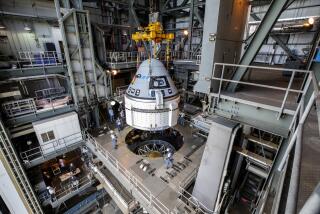Science/Medicine : It Might Save Lives--but Not in Situation Like Challengerâs : Shuttle Emergency Escape System Being Tested
CHINA LAKE, Calif. â Space agency scientists are testing a proposed escape system for the shuttle orbiter by rocketing a lifelike dummy out of an opening in the side of an airplane as it flies above the Naval Weapons Center here.
Four such tests have been conducted, all of them successful.
The systemâs purpose is to propel an astronaut away from the fuselage and wings of the orbiter during an emergency descent, allowing the astronaut to parachute safely to the ground.
It is one of two experimental escape systems developed since the 1986 explosion that destroyed the space shuttle Challenger and killed seven astronauts. NASA is not yet committed to installing either system in the next shuttle, and neither could be deployed quickly enough to be of use in a Challenger-type disaster.
But space scientists are pleased with what they have learned thus far.
âWe feel real good about the test,â said William A. Chandler, NASAâs manager of crew escape systems, after the fourth successful test last week.
The system now being tested would be put into operation if the descending orbiter could not reach a landing strip, either after an aborted takeoff or on a return from orbit.
Space scientists said the orbiter would have to be in a controlled glide and below 100,000 feet altitude before astronauts could safely blow open an escape hatch and use the system. Otherwise, they said, the air would be too thin and the shuttle traveling too fast for the astronauts to survive the escape.
Once the escape hatch is opened, a folding ramp would be placed in front of it. Each astronaut, in turn, would lie in a fetal position on the ramp, attach a cable to his or her harness, and pull a firing handle.
That would ignite a small rocket for a half-second--generating enough energy to pull the astronaut by cable through the hatch and away from the orbiter. Then, the rocket would automatically detach and the astronaut would descend to earth by parachute.
Astronaut Steve Nagel said that eight astronauts could probably escape in less than two minutes.
In last weekâs test, the dummy was ejected from a Convair 240 equipped with a simulated hatch and cruising at 200 m.p.h.--the speed at which the system would be deployed. Video tapes viewed on the ground showed the dummy being flung 40 to 50 feet from the plane, then parachuting to the ground.
Eight more tests of this system are scheduled. In January, NASA will begin testing the second proposed system, which uses a 30-foot pole extending out of the escape hatch.
The pole would bend downward and to the rear of the orbiter. In an emergency, an astronaut would attach a special harness to the pole and slide down it much like a firefighter sliding down a pole in a firehouse. The pole would carry the astronaut away from the orbiter, allowing safe deployment of a parachute.
The tests will conclude later next year, and NASA officials will then decide which of the escape systems, if any, will be installed for the June 2 launch of the shuttle Discovery.
âItâs possible that it could fly without either,â Chandler said.
The escape systems have been under development since June, when a presidential commission investigating the Challenger accident recommended that NASA explore âlimited escape capability.â
More complicated systems that might function in an explosion like the Challengerâs, such as a detachable pod for the crew or ejection seats, are also being considered. But they are in a much earlier stage of study.
NASA engineers have already fitted the escape hatch on Discoveryâs mid-deck with explosive bolts so that it can be blown off in an emergency. The hatch was manually operated in the past.
Discoveryâs astronauts will also wear partial pressure suits and closed helmets so they can survive the thin air that would be encountered if they bailed out at 100,000 feet. They will also be issued parachutes and life rafts for the first time.
In the past, astronauts have worn only a jump suit, inflatable water wings, and a helmet.
If neither escape system is added to Discovery, Nagel said, the astronauts âwould still have the option of bailing out.â But he conceded that their chances of survival without a special escape system would be poor.
HOW SHUTTLE ESCAPE SYSTEM WORKS
The astronaut lies on a ramp in front of the escape hatch, attaches a cable to his or her harness and pulls a firing lever (1). Within half a second, the rocket pulls the astronaut clear of the orbiterâs wings (2). The drogue parachute is deployed to prevent the astronaut from tumbling (3).
Source: Naval Weapons Center






